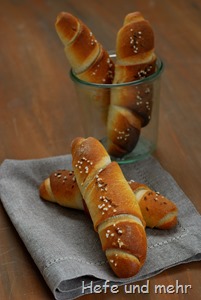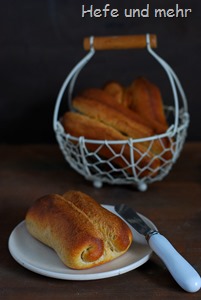 In August we spent a weekend in the beautiful Swabia. A part of my family has its roots there and I always enjoy being there. Eating some pretzels is then a “Must” of course. When we stop at a bakerie in Schwäbisch Hall, I spotted a roll made with some Emmer and Quark (Curd). But sadly the last one was already sold when it was my turn. So I bought pretzels and Briegels instead. But the idea was fixed in my head. And soon afterwards I recipe began to form in my head.
In August we spent a weekend in the beautiful Swabia. A part of my family has its roots there and I always enjoy being there. Eating some pretzels is then a “Must” of course. When we stop at a bakerie in Schwäbisch Hall, I spotted a roll made with some Emmer and Quark (Curd). But sadly the last one was already sold when it was my turn. So I bought pretzels and Briegels instead. But the idea was fixed in my head. And soon afterwards I recipe began to form in my head.
As spelt is a typical grain for Swabia, I decided to use a mix of Emmer and Spelt, which adds a nice nutty flavour to the rolls. The Quark makes it moist and if I would not know, that I added 30 % whole grain flour, I would never have guessed it.

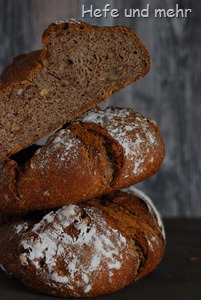
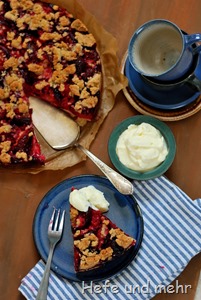 Der Liebste ist puristisch, wenn es um
Der Liebste ist puristisch, wenn es um 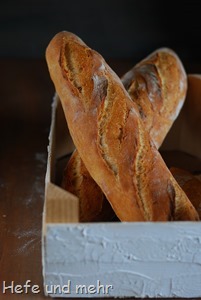 Another wish for the Bread Baking Course was Baguette. And
Another wish for the Bread Baking Course was Baguette. And 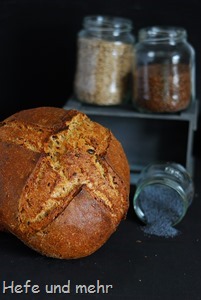 There are three different ways to soak seeds or flour: You can either cook them, or soak them in hot water or in cold water. For this bread I decided to soak the seeds in cold water. They do not absorb not as much water as when hot water is used, and this results in seeds which have still some bite. As the seeds have to soak overnight some salt is added to prevent them from fermenting.
There are three different ways to soak seeds or flour: You can either cook them, or soak them in hot water or in cold water. For this bread I decided to soak the seeds in cold water. They do not absorb not as much water as when hot water is used, and this results in seeds which have still some bite. As the seeds have to soak overnight some salt is added to prevent them from fermenting.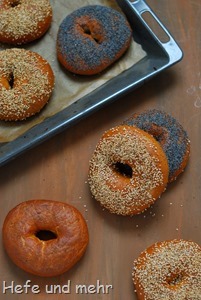 I was asked to include a bagel recipe in my little course about bread baking and I was very willing to do so. Bagels are a good recipe for beginners as the dough is quite firm and not sticky at all. Kneading on the other hand can be a little work out because of the firm dough, too. But kneading a bagel dough is important to get a chewy bagel. So turn on some music and start kneading!
I was asked to include a bagel recipe in my little course about bread baking and I was very willing to do so. Bagels are a good recipe for beginners as the dough is quite firm and not sticky at all. Kneading on the other hand can be a little work out because of the firm dough, too. But kneading a bagel dough is important to get a chewy bagel. So turn on some music and start kneading!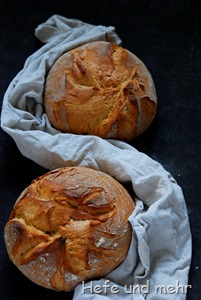
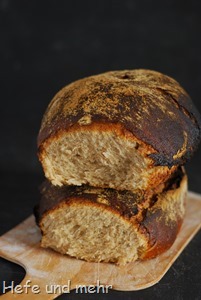 There are a lot of whishes’ for recipes for the bread baking course: the swabian “genetzes” Bread, Baguette, Bread with heirloom grains, yeasted cake, Westphalian Farmer Loaf, Sourdough and Sourdough breads, Salzstangerl, Bagel and Basler Brot. And there are still my personal wishes, a whole grain bread and a multi grain bread. We are not running out of recipes or ideas 🙂
There are a lot of whishes’ for recipes for the bread baking course: the swabian “genetzes” Bread, Baguette, Bread with heirloom grains, yeasted cake, Westphalian Farmer Loaf, Sourdough and Sourdough breads, Salzstangerl, Bagel and Basler Brot. And there are still my personal wishes, a whole grain bread and a multi grain bread. We are not running out of recipes or ideas 🙂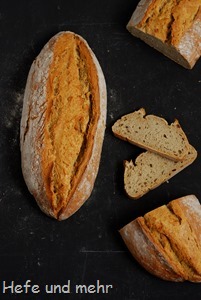 So here is now the promised Spelt bread. I know that many of the readers of this blog like to bake with spelt, but baking with spelt flour is a little bit more challenging then baking with wheat flour, so the recipe comes relatively late in my bread baking course.
So here is now the promised Spelt bread. I know that many of the readers of this blog like to bake with spelt, but baking with spelt flour is a little bit more challenging then baking with wheat flour, so the recipe comes relatively late in my bread baking course.